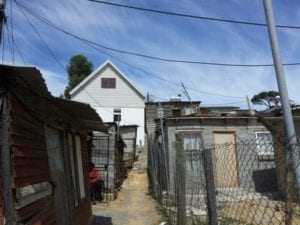DPI Plastics has played an important role in improving the living conditions of residents of informal settlements after donating PVC building pipes and fittings to the first-ever shack-to-house conversion project in Kayamandi, Western Cape.
The test phase of the Kayamandi project, which was completed in March 2013, involved the conversion of a 23 m2 wooden shack into a solid 46 m2 double-storey home made entirely from ‘sand bag’ eco bricks built by 16 ‘off-the-street Kayamandi residents’ who were trained and supervised by an engineer from the Africa Responds Clearly Eco Homes team. The project’s test subject, Norie Lungisa, who lived in the cramped and uncomfortable conditions of her shack with her two children for more than 10 years, is delighted with her new and improved eco brick home, which was officially handed over to her on 14 March 2013. Cape Town-based construction materials supplier Penny Pinchers approached 16 of its most trusted suppliers, including DPI Plastics, to assist the Kayamandi project with various donations. As a socially responsible corporate citizen, DPI Plastics places a strong emphasis on supporting community development projects, notes the company’s marketing manager, Martine Goodchild. She says: “DPI Plastics is committed to supporting projects that aim to uplift the living standards of fellow South Africans, especially with regards to adequate housing. The Kayamandi project supports DPI Plastics’ vision of building a better tomorrow, not only by providing residents with better housing facilities, but also by creating employment and skills development opportunities for locals. We also encourage the use of ‘green’ building materials that aim for energy efficiency within the home.” Africa Responds Clearly Eco Homes spokesman Grahame Tomes highlights the fact that the new eco home is comprised of two upstairs bedrooms, in addition to an open plan lounge, dining and kitchen area and a bathroom. “It is our plan to help the Lungisa family with the added benefit of receiving running water and a sewerage connection from the relevant authorities, once the authorities are able to generate enough budget to help the residents of Zone 14 in Kayamandi.” Tomes explains that the Kayamandi eco house is built utilising the National Home Builders Registration Council (NHBRC)certified eco brick/eco beam building system, which employs eco bricks and eco beams that are plastered and painted. “All eco brick houses are built with eco bricks that are 300 mm x 300 mm in size. The net result of such wide bricks is a home which is cool in summer and warm in winter,” he continues.According to Tomes, eco brick homes address a number of serious challenges that are currently facing the South African affordable housing industry.
“The 300-mm thick walls provide a natural barrier to the harsh South African sun – even in temperatures exceeding 40 oC. The issues of rising damp, rain and even flooding are entirely eliminated with eco brick houses, as water cannot rise through sand. Instead, it is forced back downwards into the earth.” Tomes points out that the construction of eco brick homes also empowers communities. “Residents are provided with employment and skills development, while playing an important role in developing their community. Under this scheme, we are able to employ approximately 1 000 people per community over a three-week period. During this time, we train them and equip them with the necessary skills to build around 120 high-quality eco brick/eco beam homes per month, in each respective community,” he adds. Another distinct advantage of eco brick houses is a reduction in overall costs, when compared to cement block houses. “The current government subsidy of R84 000 for first time home buyers is sufficient to build a 50 m2eco brick or eco beam double-storey house. All the tests completed by the CSIR, the SABS and the NHBRC show that eco brick houses offer better performance specifications than those built with cement bricks and blocks or even steel structured houses,” says Tomes. Despite their initial reservations, Tomes indicates that all 48 members of the Loyola Street Committee – where the transformed shack is located – are queuing up to have their shack homes replaced too. “The building of this first ever shack replacement double-storey home has been an overwhelming success, and would not have been possible without the support of all of our generous donors. We offer our sincere thanks to them all.”







